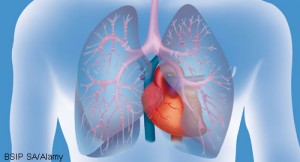 ACR CONVERGENCE 2020—Interstitial lung disease (ILD) is the main cause of death of systemic sclerosis (SSc) patients, and predicting its progression, which can fluctuate dramatically from patient to patient, has proven to be a complex endeavor.
ACR CONVERGENCE 2020—Interstitial lung disease (ILD) is the main cause of death of systemic sclerosis (SSc) patients, and predicting its progression, which can fluctuate dramatically from patient to patient, has proven to be a complex endeavor.
But a deepening understanding of how to monitor patients for ILD severity, as well as brightening prospects for therapy, were discussed in a Nov. 6 session at ACR Convergence.
Important Role of Monitoring
Monitoring is crucial to helping clinicians help their patients achieve the best outcomes possible, said Anna Hoffmann-Vold, MD, PhD, head of SSc research and SSc outpatient clinic at Oslo University Hospital, Norway. Recent research she led showed the unpredictable nature of ILD progression, pointing to the need to avoid relying only on baseline characteristics and instead track the entire picture of each patient.
Using the European Scleroderma Trials and Research (EUSTAR) database, researchers assessed the lung function of 826 patients with SSc-ILD, 535 of whom had multiple forced vital capacity (FVC) measurements available over an average of five years of follow-up.1 Over each 12-month period, about a third of the patients showed progressive ILD, but only a small portion of them showed rapidly progressive disease with FVC decline in every consecutive period.
Most patients, researchers found, followed a path of long, slow decline, with periods of stability, or even improvement, followed by decline. In fact, they found a third of the patients had no episodes of FVC decline. Over five years, the strongest predictors of FVC decline were male sex, a higher modified Rodnan skin score and reflux or dysphagia symptoms.
With this amount of variation in the clinical course of SSc-ILD, baseline high-resolution computed tomography is only partly helpful in predicting how patients will fare, Dr. Hoffmann-Vold said, although having no ILD at baseline is a good prognostic marker, with few of these patients going on to develop SSc-ILD.
As clinicians continue to assess the severity of ILD in their patients, a variety of measures should be used, Dr. Hoffmann-Vold stressed.
“Don’t rely just on one measure to assess severity and also, even more importantly, assess the risk of progression in your patients,” she said.
Dr. Hoffmann-Vold pointed specifically to oxygen desaturation on exercise tests. A study of SSc-ILD patients found that combining this metric with whether the patient has had arthritis seems to be a powerful predictor of ILD progression.2 Those who desaturated to 94% or lower during a six-minute walk test had a 36% chance of ILD progression over the next 12 months, and that finding, along with having had arthritis, meant an 86% chance of ILD progression, she said.
New Therapies
With last year’s approval of the tyrosine kinase-inhibitor nintedanib and trial results of the antifibrotic agent pirfenidone awaited, it is an exciting time for the treatment of SSc-ILD, said Richard Silver, MD, professor of medicine and pediatrics at the Medical University of South Carolina, Charleston.
“I think we’re on the cusp of a new era of treatment for this very serious complication of scleroderma,” Dr. Silver said.
The recent progress and the promise for even more treatments are a welcome evolution for a sector of the rheumatology field that until only a few years ago had cyclophosphamide, with its long-term safety concerns, as its main option.3
Mycophenolate mofetil, with the publication of the Scleroderma Lung Study II, became another option for patients, as they were able to remain on the drug longer than they could stay on cyclophosphamide, Dr. Silver said.4 And last year, the U.S. Food & Drug Administration approved nintedanib, which showed statistically significant improvement in slowing the rate of FVC over a year, compared to placebo, whether or not it was combined with mycophenolate mofetil.5
In the Scleroderma Lung Study III trial, researchers are evaluating the efficacy of the up-front combination of mycophenolate mofetil plus pirfenidone, compared to mycophenolate mofetil plus placebo.6 Pirfenidone is already approved for idiopathic pulmonary fibrosis.
Rituximab and tocilizumab remain possible options for SSc-ILD patients in the future, but so far the evidence is inconclusive—for instance, in the faSScinate trial of tocilizumab, the primary endpoint of change in skin score wasn’t met, but the data suggested that it tended to stabilize lung function in patients with ILD, Dr. Silver said.7
“We need additional trials for both of these agents,” Dr. Silver concluded.
Thomas R. Collins is a freelance writer living in South Florida.
References
- Hoffmann-Vold AM, Allanore Y, Alves M, et al. Progressive interstitial lung disease in patients with systemic sclerosis-associated interstitial lung disease in the EUSTAR database. Ann Rheum Dis. 2020 Sep 28;annrheumdis-2020-217455. [Epub ahead of print.]
- Wu W, Jordan S, Becker MO, et al. Prediction of progression of interstitial lung disease in patients with systemic sclerosis: The SPAR model . Ann Rheum Dis. 2018 Sep;77(9):1326–1332.
- Tashkin DP, Elashoff R, Clements PJ, et al. Cyclophosphamide versus placebo in scleroderma lung disease. N Engl J Med. 2006 Jun 22;354(25):2655–2666.
- Tashkin DP, Roth MD, Clements PJ, et al. Mycophenolate mofetil versus oral cyclophosphamide in scleroderma-related interstitial lung disease (SLS II): A randomised controlled, double-blind, parallel group trial. Lancet Respir Med. 2016 Sep;4(9):708–719.
- Distler O, Highland KB, Gahlemann M, et al. Nintedanib for systemic sclerosis-associated interstitial lung disease. N Engl J Med. 2019 Jun 27;380(26):2518–2528.
- University of California, Los Angeles and Genentech Inc. Scleroderma lung study III—Combining pirfenidone with mycophenolate (SLSIII)(NCT03221257). ClinicalTrials.gov. 2017 July 18.
- Khanna D, Denton CP, Lin CJF, et al. Safety and efficacy of subcutaneous tocilizumab in systemic sclerosis: Results from the open-label period of a phase II randomised controlled trial (faSScinate). Ann Rheum Dis. 2018 Feb;77(2):212–220.
